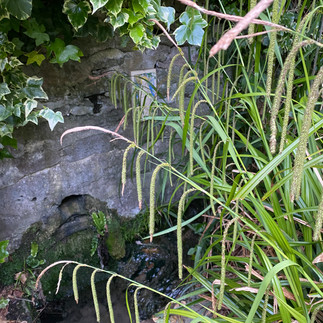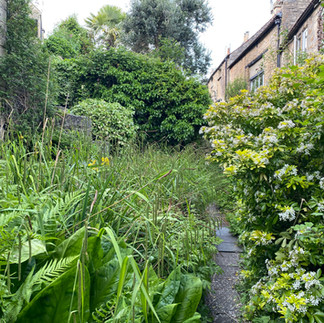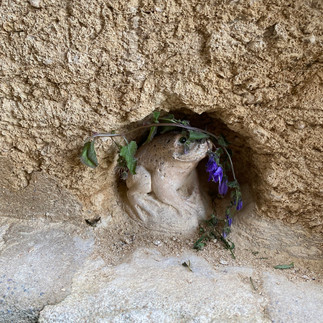The Nooks and Crannies of Bradford on Avon
- Glyn Coy
- Oct 7, 2023
- 4 min read
Updated: Oct 8, 2023
I must confess to being terribly late to write this particular piece. It was over two years ago now that I met Bo Novak, a friend of Hidden Wiltshire, who very kindly spent an evening showing me around Bradford on Avon. It is a town I thought I knew well. I had visited many times and walked around what I thought was all the interesting parts. Surely there couldn't be enough unknowns to justify a write up on the Hidden Wiltshire website? Bo proved me to be very wrong about that.
What follows is a visual tour around the central part of the town. There will be many familiar things to see along the way, blended with the little surprises that pop up in the nooks and crannies along the way. It tells a deeper story of the human history of Bradford on Avon, a place that has been home to people for thousands of years.
The first place we went to was to seek out a piece of more recent history. On St Margaret's Street across the road from the War Memorial we found "Millie". Unveiled in 2000 as a statue to commemorate the millennium, she represents the long history of the people of Bradford on Avon with clear links to the cloth and wool trade, carrying a distaff and spindle. Reminding us of how important women were to the town's industrial past, she releases a dove of peace providing hope for the future.

Crossing the road from here into the gardens around the war memorial, we find commemorative signs about some troubling historic incidents. A bronze plaque on the side of the tourist information office remembers six dead members of the Royal Canadian Air Force, who died in the town in a plane crash on 26th March 1944. Walking over towards the river we see another plaque high on a wall overlooking the river, marking the flood level on 25th October 1882. Bradford on Avon does flood quite often in the winter. The River Avon that flows through can be unforgiving when the water table rises. But the flood level of 1882 is ridiculously high. Standing there and trying to imagine it boggles the mind.
Heading out of the gardens towards the footbridge over the river we saw the Bradford on Avon Twinning Garden, commemorating its twin towns of Norden in Germany, Sully-Surloire in France and Elblag in Poland. Then as we approached the bridge we had to first traverse the "Jazz Carlin Steps". Jazz won two Olympic silver medals in swimming at Rio in 2016. Another sign informed us that we were heading over McKeever Bridge, dedicated to Olympic gold medallist Ed McKeever, a sprint kayaker from London 2012. Back in the London Olympics, British gold medallists also had their local post boxes painted gold, and Bradford on Avon was no exception. Its gold post box sits at the end of The Shambles.

As you go across the bridge you see the iconic Abbey Mill building right next to the river.
Over the bridge we then had a look around the outside of the Wallington Hall, which is now owned and use by the local Masons. Although it has two levels to the building, access to the upper floor appeared to be via a door at the back, as the road to the left of it leads uphill and around the back of the upper level. I wondered whether it had a staircase inside, or whether the two levels are split, and self-contained?

Further along Church Street and on the corner of Market Street we stopped to look at the outside of the St Thomas More Catholic Church. Originally the Town Hall, it was completed in 1854. It has a distinctive front facade, with an octagonal tower which has an onion dome. It was designed by Bath architect Thomas Fuller, who went on to be the Chief Dominion Architect for the Government of Canada between 1881 and 1896. So, this wonderful civic building in a small Wiltshire town was designed by the same man who designed most of the federal government buildings in Canada.

Across the road from the church is The Shambles, the town's old medieval street which while much smaller than its namesake in York, is definitely worth a look.

We headed back along Church Street, past the Saxon Church (which Paul Timlett recently covered in this blog post here: Saxon Church ). Halfway up the hillside of residential streets we went down a back alley, which was abundant with greenery and felt almost sub-tropical. Fairly soon we were upon a spring, with water flowing into underground tunnels. The moisture was providing year-round sustenance for the vegetation, which is why everything is so green. I won't disclose the exact location to keep this one hidden, but there is evidence of the water flows higher up the hill with the Newtown Spout. At one point these springs provided a natural water source for the whole town.
We carried on further uphill to explore the old mill workers cottages above Newtown. The upper level is known as The Tory, and I have to say that these cottages are delightful. There is no road here, just a footpath in front of the houses. Each house has a terraced garden overlooking the whole town, and the view extends across to Salisbury Plain in the distance. St Mary's Chapel offers a rest stop for weary travellers, and some benches in the garden there offer a place to catch your breath after the steep climb up.


We did encounter a few other surprises along the way such as a stone frog in a wall, a King Edward VII post box and the odd green plaque.
Overall though this whole experience told me something else. That too often, we breeze through a place to do something, to get somewhere. It is only when we take the time to stop, look, listen, observe that we find the real character of a place. It means we approach it with no agenda, no real place to go, no mission to accomplish. When we do that with eyes open, we see the things that are hidden.

Many thanks to Bo Novak for the inspiration for this one - it is a long overdue write up !
























